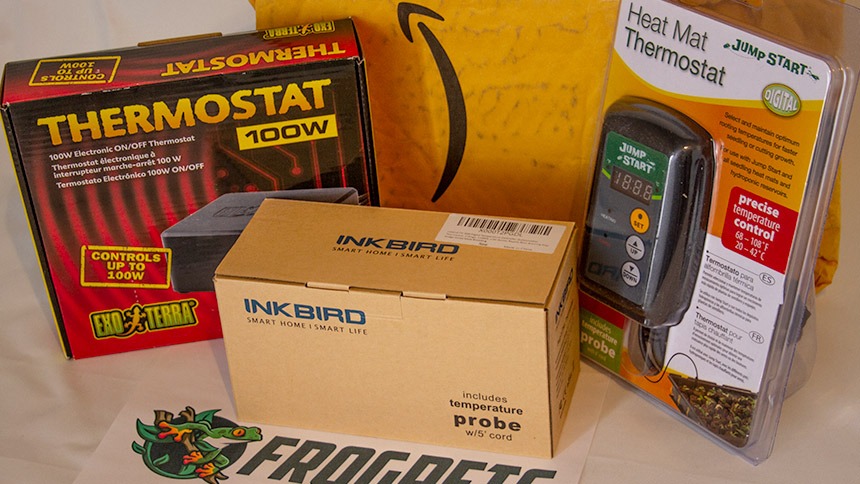
Best Thermostats for Reptile & Amphibian Enclosures
Temperature plays a huge role in the health and well-being of all animals, especially reptile and amphibians. Reptiles are ectothermic, which means they can’t produce heat in their own bodies. They depend on their surroundings and the ambient temperature to keep warm.
Because of this, we reptile owners do our best to provide our pets with the recommended amount of heat. It’s super important to maintain their health. After all, our pets have a special place in our hearts and keeping them comfortable is what matter’s the most.
Heating devices such as ceramic heat emitters, heating pads, heat tape, and basking lamps do well at warming reptile enclosures but it’s best to pair them with a thermostat. A thermostat regulates the temperature by telling the heater to turn on or off. If its too cold, the heater turns on. Too hot and the heater shuts off.
A good thermostat makes a massive difference in the health of frogs, snakes, lizards, turtles, and other exotic animals. That’s why I’ve taken the time to create a comprehensive guide for buying a thermostat.
By the end of this page, you’ll feel confident knowing which thermostat is best for you. Rest easy knowing the heating elements are safely providing the perfect amount of heat for your reptiles and amphibians.
The first step is to determine which type of thermostat you need. Don’t worry, I’ve got you covered. I’ll show you which brands are most accurate and most importantly, which thermostat is right for your setup.
Listed below are the four thermostat brands I think you’ll like. But please, don’t pick one yet; it’s just to show you which ones I’ll be comparing in the review section.
| Image | Description |
|---|---|
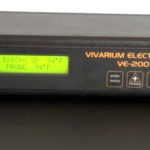 | Vivarium Electronics (Best Overall, Expensive) Another top-notch device. It has basically anything you need to regulate your enclosures |
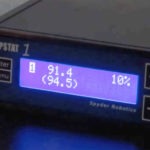 | Herpstat Top of the line with all the bells and whistles. It’s expensive, but worth it if you need extreme accuracy. |
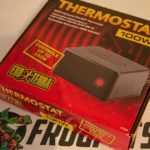 | Exo Terra Thermostat (Highly recommended) Highly recommended. This thermostat has some amazing features for the price. |
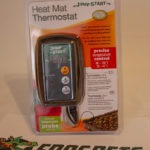 | JumpStart Digital Thermostat A quality thermostat and the least expensive thermostat on this list. Good for single heater setups. |
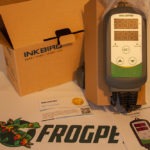 | Inkbird ITC-308 Great for beginners. One of the best thermostats available. Has dual sockets; heating and cooling. |
Page Contents
Different Types of Thermostats
Learning the difference between the three types of reptile thermostats is the first step to deciding which is best for your setup. Once you know the kind you need, I’ll reveal which products are the best for each type of thermostat. So, let’s get started.
On/Off Thermostats
An “On/Off” thermostat works by turning on the heater when the temperature is too cold. Likewise, they also turn the heater off when it gets too hot.
I’ll give you an example of how this works but first, let’s go over the basics. Plug in the thermostat and input the desired temperature. The temperature is determined by the needs of your reptile. Whatever you input here will determine how hot or cold it gets within your pet’s enclosure.
Most on/off thermostats are digital but there are a few analog options as well. Anyway, once you’ve set the temperature its time to plug your heating device into the thermostat. This can be a heat mat, ceramic heat emitter, heat tape, etc.
Last but not least, it’s time to place the thermometer probe within the enclosure. The probe is the part that reads the temperature. When it gets too hot, it tells the thermostat to shut off the heater. When it gets too cold, it tells the thermostat to turn on the heater.
So, that’s a quick overview of how on/off thermostats work. Now let’s look at which types of heating elements work best with them.
For the most part, they’re designed to work well with heat mats. Things like under tank heaters or heat tape. Technically speaking, they will work with ceramic heat emitters but it can be challenging to accurately gauge the heat. The probe is most accurate when taped to the heating source (like a heating mat).
- Best For Under Tank Heaters & Heat Tape – Works with Ceramic Heat Emitters
- Accurate Within (About) 5 Degrees Fahrenheit
Now let’s look at why you may or may not want to use an on/off thermostat.
The temp in your reptile’s enclosure will change constant. Lets say you set the temperature to 85 degrees Fahrenheit. The heater kicks on and warms the enclosure to 86 – 87 degrees and then it shuts off. The temp drops to 84 – 83 degrees before the thermostat turns the heater on again. This happens over and over again.
It isn’t a problem for say, a bearded dragon. However, it is a problem for incubating python eggs, where a constant temperature is needed.
The question to ask yourself is: one, do you need a consistent, level temp or is it okay for the temperature to fluctuate continuously? And two, how accurate does it need to be?
If the species you’re keeping isn’t too picky, then an on/off thermostat is a great option for you.
Proportional Thermostats
The other two types of thermostats are considered to be more accurate within the reptile community. They’re what are known as “Proportional Thermostats.”
A proportional thermostat works by regulating the amount of power going to the heating device. They can restrict the voltage to make the heater produce less heat. Likewise, they release more voltage to make the heating device warmer.
To clarify things, a proportional thermostat does not turn a heating device on or off. It simply controls the amount of power going to it.
Proportional thermostats are easier on reptile heaters and because of that, they tend to last longer than they do when paired with an on/off thermostat. Not only that, they’re the best at holding a consistent temperature. They’re also more accurate in general. As you probably suspected, they cost more too.
Anyway, let’s have a look at the two types of proportional thermostats.
Pulse
Pulse proportional thermostats work by sending pulses of power to your heating element. The longer the pulse, the hotter the heater gets. Out of the two proportional thermostats, this one is fastest at getting an enclosure up to the correct temperature.
However, due to the nature of its design, pulse proportional thermostats arenot the best for lights or basking lamps.
- Best For Ceramic Heat Emitters, Heating Pads, & Heating Tape
- Most Accurate Temperature
Okay, so why would you want a pulse proportional thermostat? Well, because they offer accurate and constant temperatures. Also, heating devices have been known to last longer when paired with proportional thermostats. This will save you some money in the long run.
If you need a constant, level temperature within your reptile’s enclosure, then a proportional thermostat is what you need. Get a pulse proportional thermostat if you’re using heating pads, heating tape, or ceramic heat emitters.
Dimming
The last of the three kinds of reptile thermostats is dimming proportional. It works by restricting the power going to the heater. A dimming thermostat slowly bumps up the power until the perfect settings are obtained.
In contrast to pulse proportional where pulses of power are sent to the heater, a dimming thermostat restricts and adjusts a consistent flow of power until the correct temperature is met.
Because of this, they’re more suitable for controlling basking lamps.
- Great For Basking Lamps, Ceramic Heat Emitters, & Heating Pads
- Most Accurate Temperature
While these are probably the most accurate of the three, they can take several days to find the perfect settings; only during the initial setup, though. With that in mind, you need to give a new dimming thermostat several days to find the perfect settings and adjust the temperature. Do this before moving your reptiles (or eggs) into their enclosure.
Now, let’s talk about who would want a dimming proportional thermostat. Well, someone who values accuracy and level temperatures within their pet’s enclosures.
If you own ball pythons, for example, and you’re attempting to incubate the eggs, you’ll want something with pin-point accuracy. Something that can maintain a constant temperature. This is the one you want.
Which One Do I Need? Why?
I know I just dumped a ton of information on you and I don’t want you to feel overwhelmed. Learning this stuff takes time and experience. I’m going to do my best to help you decide which is best for you in the next few paragraphs.
The needs of your pet and habitat setup will determine which thermostat is best for you. Does the temperature accuracy need to be perfect or will a 5-degree variation be acceptable? Do you have one enclosure or a whole rack? Will you be incubating eggs? How many heating elements will your thermostat control?
- If you have one reptile enclosure – Chances are, you don’t need a fancy thermostat. Most keepers fall into this category. Controlling one ceramic heat emitter or UTH (under tank heater) is enough to keep your reptile or exotic pet happy. If this is you, I recommend a simple on/off thermostat.
- If you have a rack of reptiles, multiple heaters, or you’re incubating eggs – Or you see yourself in this situation in the near future. You probably own an on/off thermostat already and you’re looking for an upgrade. You need pulse or dimming probation thermostat with more than one probe; something capable of controlling multiple heaters with great accuracy.
One really good product lands in-between the top-rated, most expensive reptile thermostats and the cheapest on/off devices. It’s a proportional thermostat from Exo Terra.
The Exo Terra thermostat isn’t the most robust device but it’s super accurate and costs about half the price of best ones. This makes it a great buy for someone who wants accuracy in a single reptile enclosure but doesn’t want to spend a lot of money.
The 5 Best Reptile Thermostats Reviewed
This section compares and reviews some of the best brands and products on the market. It’s worth mentioning that these companies offer several models with different features.
For that reason, I’ll talk about the brands as a whole and then recommend a certain model at the end.
Vivarium Electronics
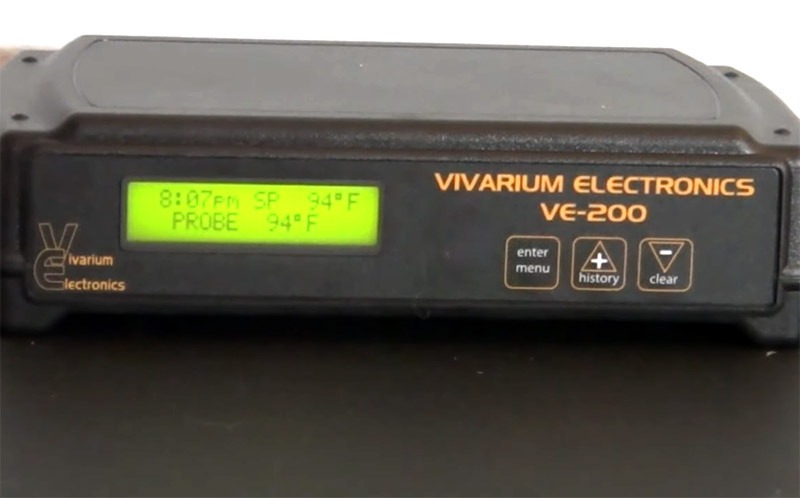
Brand: Vivarium Electronics
Type: VE-300
Thermostats from Vivarium Electronics are another favorite within the reptile community. Young herpetologists world-wild have been using these stats for years now and for good reason…
Accuracy is top-notch, the design is admirable, and they come with some of the most advanced features available. As of now, Vivarium Electronics makes 6 different models.
There is the HobbyStat which is an analog, on/off type. The VE-100 and VE-High Power are on/off stats, too. My favorites are the VE-200 and VE-300, which are offer pulse and dimming proportional. Finally, the VE-300×2 is pulse proportional but it has two outlets to control two different areas.
One of the coolest features is the design. Most of them are stackable. Since Vivarium Electronics doesn’t offer much in the way of controlling several heaters from a single system, they’re designed to stack. This is great because you’ll need one thermostat for each of your reptile enclosures. That is, unless you buy the VE-300×2, which has two outlets.
- Proportional or On/Off (Model VE-200, 300)
- Ranges from 40 °F – 150 °F
- Audible Alarm & Safety Shut Off
- Retains Setting (even after a power outage)
- 450 – 700 watt per output
- Built-in Night Drop (VE-300 only)
- Stackable Design
The model I recommend from Vivarium Electronics is definitely the VE-300×2. The reason for this is simple; it has two power outlets. This allows you to easily control the temperature of two heating elements.
Herpstat
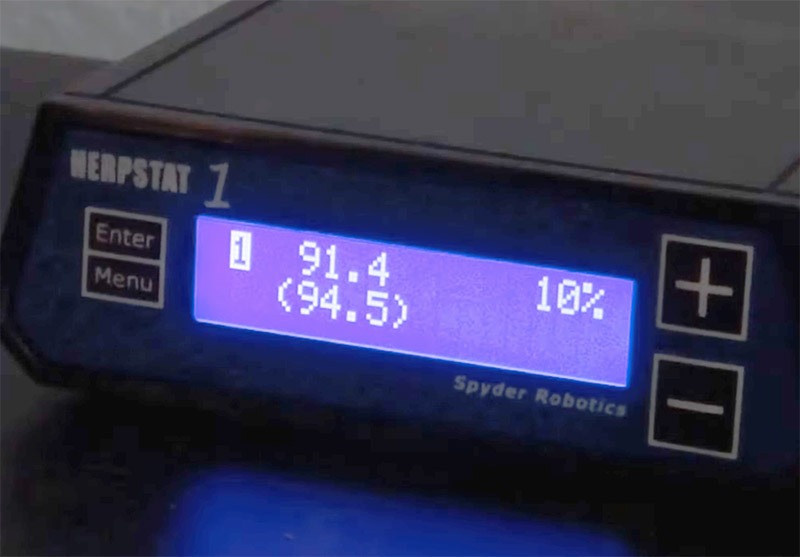
Brand: Herpstat
Type: 1 – 6
Spyder Electronics is the company making the Herpstat line of thermostats for reptile tanks. Their products are the top of the line, offering the most features and accuracy.
At the time of writing this, they make 12 different models, ranging from $80 to $440. Nearly all of them include the same features but the main difference in price boils down to the number of probes and outlets a single machine controls.
They offer digital or analog. Only two of them are analog and they come in either one or two probe setups. The digital display Herpstats range from one probe to six probes and they include all the bells and whistles you’d expect in a top-notch thermostat.
- Pulse & Dimming Proportional
- Ranges from 40 °F – 150 °F
- Audible Alarm & Safety Shut Off
- Retains Setting (even after a power outage)
- 375 – 700 watt per output
- Accurate within 0.9 °F
- Night Drop Capability
Now that you know more about the Herpstat line, you’re probably wondering which model best for you. Most of the time it comes down to how many enclosures you’re trying to heat with the same thermostat.
If you have one or two setups, the Herpstat 2 is a great option. It offers two outputs (two power outlets and two temp probes). It has a digital display, programmable night drops, alarm system, safety shutoff, and much, much more.
The only real downside is the cost. These aren’t cheap on/off thermostats, after all. They’re highly accurate and very dependable. It’s money well-spent, too.
You’ll have peace of mind knowing your reptiles are basking in the perfect temperature day and night. Not only that, you’ll be notified (by alarm) if your pet’s enclosure gets too cold or hot.
Exo Terra Thermostat
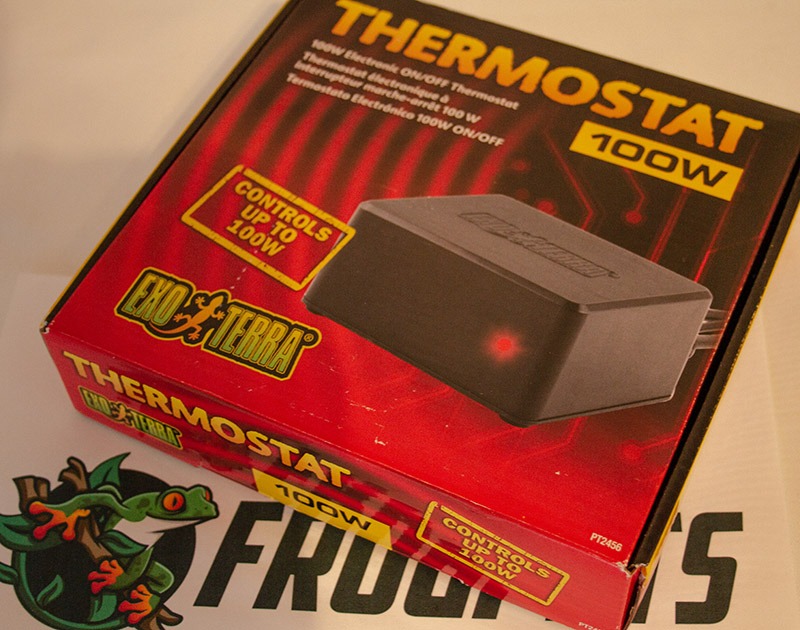
Brand: Exo Terra
Type: 600W
Exo Terra as a company that makes one of the best reptile terrariums and a long list of quality products for snakes, turtles, lizards, and frogs. It should come as no surprise that they offer a thermostat too.
As it were, they offer three variations that I know of. The main difference between the three is the max wattage and display. The first two are analog displays and they can handle either 100w or 300w max. Exo Terra’s newest one, on the other hand, can handle up to 600w and features a nice digital display.
The 600w thermostat is the model I recommend. It has great features for the price, considering it costs less than half as much as the Herpstat 2 and the VE-300×2.
- Dimming & Pulse Proportional (600w version)
- Ranges from 50 °F – 140 °F
- Easy-to-read LCD display
- 600 watt
- Night Drop Capability
Despite everything this thermostat has going for it, there is one minor problem. Many keepers have complained about the light sensor not working properly. It has night drop functionality but the nighttime hours aren’t programmable; a light sensor determines when its night.
This is a problem if you’re keeping reptiles in your basement or a room with low light. Even placing the probe in a bad position can result in the sensor thinking its nighttime.
If low-light is not an issue with your setup, the Exo Terra’s 600w thermostat is a great option. Its features aren’t as robust as Herpstat’s or VE but it costs a fraction of the price.
Jump Start Digital Thermostat
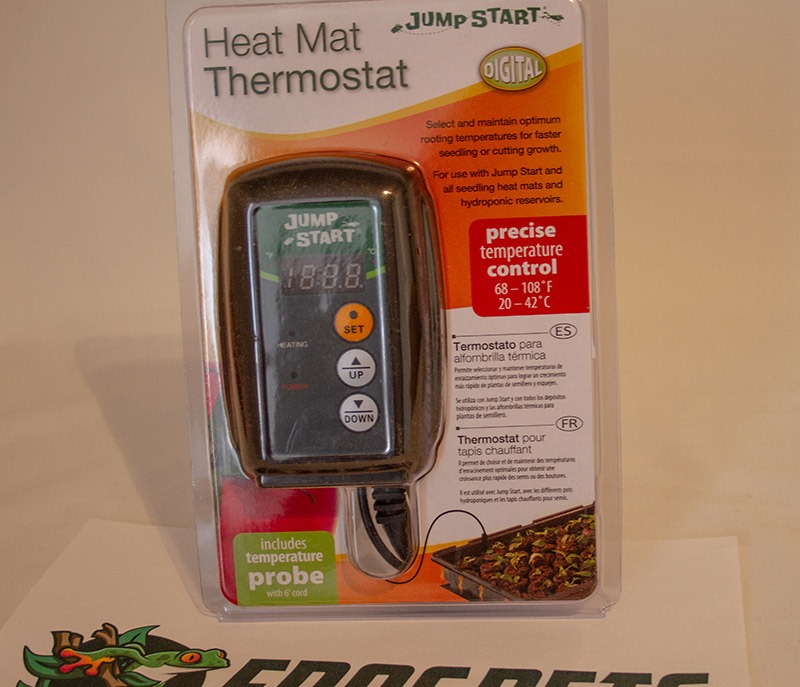
Brand: Jump Start
Type: Digital Thermostat
This On/Off Thermostat from Jump Start is one of the most popular among reptile keepers. It’s gaining popularity due to its ease of use, accuracy, and, of course, the price.
Remember, on/off thermostats work by turning the heating device on and off. The heater is turned on when the temperature is too low and it’s turned off when the temperature is too high. Simple, right?
You may remember me saying their accuracy is not as good as proportional thermostats. While that is true, they’re good enough for most exotic pet habitats.
The only time I don’t recommend on/off thermostats is if you’re incubating eggs or you need a consistent, level temperature. These thermostats cause the temperature to fluctuate continuously (within a certain range, of course).
Most exotic pets tolerate and thrive in a 10 – 15-degree range of temperature. The Jump Start product is accurate within 5 – 8 degrees, making them a great option for casual herpetologists.
- On/Off Thermostat
- Ranges from 68 °F – 108 °F
- Digital display
- 1,000 watt max
- Least expensive on this list
Let’s face it, this thermostat isn’t the most impressive and it certainly pails in comparison to Herpstat or Vivarium Electronics. But, it’s also much, much cheaper. Not only that, it’s well-equipped for regulating the temperature is most reptile terrariums.
Look, the expensive thermostats are great. If you can afford one, I recommend it. Go for it. If you can’t, don’t worry – you’re not alone. My wife and I used a Zilla analog on/off thermostat for years and it worked great. This product is even better (in my opinion).
In fact, unless you absolutely need something like a Herpstat, this is the product I recommend. Especially for those of you just getting into the hobby.
Feel confident knowing your reptile or amphibian isn’t overheating or freezing to death – and feel even better knowing you’re saving some money by going with the Jump Start Digital Thermostat.
Inkbird ITC-308
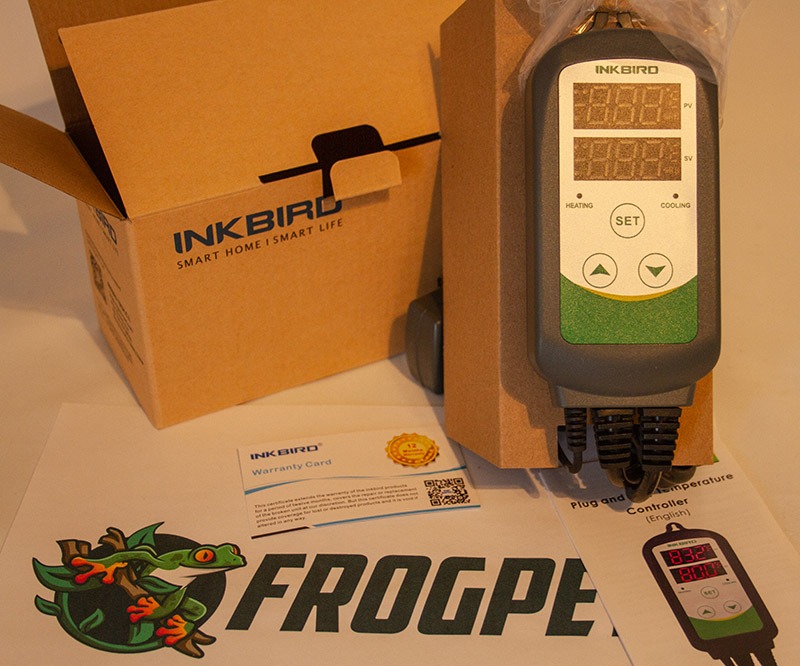
Brand: Inkbird
Type: ITC-308
You can’t go wrong with this thermostat. It’s built extremely well, easy to use, and has a unique featured compared to most other on/off thermostats.
The ITC-308 has dual sockets allowing for both heating and cooling. You may be wondering what purpose the cooling socket has, considering most pet enclosures typically require a heater only. Well, the ITC-308 wasn’t designed specifically for reptile and amphibian husbandry, although it works exceptionally well for this.
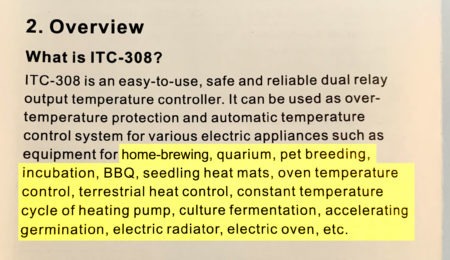
As you can see, there are lots of ways this product can be used. While the cooling socket might not be helpful regulating your frog’s enclosure, it does serve a purpose.
- On/Off Thermostat
- Ranges from 58 °F – 248 °F
- Digital display
- 1,200 watt max
- Dual output for heating/cooling
- 1 year warranty
Inkbird did a fantastic job on the ITC-308. Honestly, if you don’t need a “night drop” function, this is the thermostat to get. It’s easy to use, well-built, and even comes with a one year warranty.
Why You Need A Thermostat For Your Reptile’s Enclosure
I assume you already know the importance of having a reliable thermostat running the heating elements within your terrarium. In case you don’t know, I’ll cover the basics here. Feel free to skip this and go straight to the “Features To Look For” section if you already know this stuff.
The main reason to use is thermostat is for the comfort and well-being of your pet – naturally. All animals, especially reptiles, require a certain level of warmth to survive. The required temperature depends on the climate of the place of the world they come from.
Species from tropical regions often require moderately high temperatures and high humidity. Keeping them at room temperature works for some species but not all. That’s where a heater and thermostat come in. The heater will warm their cage but you need a reliable thermostat to shut the heater off when the temperature gets too high.
Thermostats not only protect your reptiles but they can protect your house from a faulty heating element. Most of us are gone to work during the day. During that time, the heater is running and warming your pet’s enclosure. This is a problem if the heater malfunctions.
The chances of that happening are rare. Regardless, having a thermostat with an emergency shut off system will add some protection against this. As always, follow the safey guide lines provided with heating devices and thermostats.
Features To Look For
The features are the first things to look at when shopping for a reptile thermometer. But what if you’re new to the hobby or simply don’t know what to look for? That’s precisely what this section is for…
Digital or Analog?
The part you’ll be interacting with most is a digital display buttons or analog control knobs. Which do you prefer? They’re both easy to adjust and understand.
For analog thermostats, simply turn a dial to set the temperature you want. Zoo Med and Herpstat both make analog versions of their products. Zoo Med has a cheap on/off thermostat while Herpstat’s EZ2 is a dual output proportional thermostat (it controls 2 separate heating devices with better accuracy). Both are great products – don’t feel like you’re limited to using just a digital display.
Most thermostats in the reptile industry feature a digital display. They, like the analog ones, come in a wide range of prices. Jump Start has a great on/off digital thermostat for less than $40. On the other end of the scale is the Herpstat 6, which features 6 separate probes and unbeatable accuracy – it’s $439.
The point is, whether you go with digital or analog, you’ve got great options.
Max Wattage
The maximum wattage rating indicates how many watts the thermostat can handle. This is referring to how much wattage is used by your heating device. So, let’s say you have two 100w ceramic heat emitters using a combined total of 200w. If the thermostat has a max wattage rating of 200w or more, then you’re good to go.
Be sure to know the total number of watts your setup is using before buying a thermostat.
Safety Shutoff
This is a comforting feature some thermostats have. It does exactly what you’d expect; it shuts down the heating devices if problems arise.
If a UTH (under tank heater) malfunctions, for example, the safety shutoff will activate by cutting off the power to the heater.
Alarm System
This is a feature mostly found in the expensive reptile thermostats. The alarm system makes an audible sound that indicates when your reptile’s enclosure is too hot or too cold.
Night Drop
Anyone who has owned a reptile or amphibian can tell you that they almost always require a drop in temperature at night. The reason is simple. As the sun goes down at night, the temperature drops on wild animals around the world.
Being as meticulous as possible, we reptile keepers do our best to recreate our pet’s natural habitat. To do this, the temperature needs to drop in their enclosures at night.
A “night drop” feature does just that; it drops the temperature during the nighttime hours. The means in which a thermostat does this varies between brands.
For example, the Exo Terra Thermostat uses a light sensor to determine when its night. Others, like the Herpstat, can be programmed to perform a night drop at a certain time of day. Both have their pros and cons but programming the night drop time manually is the most preferred method.
I’ve seen countless complaints about faulty light sensors thinking its nighttime during the day hours. This can be a huge problem if you keep your reptile(s) in a basement or a room with little or no natural light.
Multiple Plugin Outlets & Probes
Perhaps the most important feature of a thermostat is how many different heating devices it can control at the same time. This is especially important when heating housing multiple reptiles.
One might think “Can’t I plug in a multi-outlet adapter to a single-outlet thermostat and run several heaters?” Yeah, I suppose you can. But don’t – that’s dangerous. Also, there are two problems with that idea.
One, when the thermostat turns the heater off, it will turn off all the heaters plugged into the adapter. Two, despite running multiple heaters, you still only have one probe.
The probe, if you remember, is the part that reads the temperature. To simplify things, you need a probe for each enclosure you want to control the temperature in.
To accurately control the temperature in more than one cage, like a reptile rack, you’ll need multiple outlets and probes. That or you’ll need multiple thermostats. Vivarium Electronics makes stackable thermostats if that’s what you prefer. On the other hand, Herpstat has one model with six different probes.
Warranty
This last one is less of a feature and more of reassurance. It’s one thing to have a $40 on/off thermostat break on you but it’s a different story if a $200 setup fails. For that reason, many of the expensive models come with a warranty.
TL;DR – Conclusion
Well, friend, you did it. You consumed a giant portion of thermostat goodness! Or, perhaps, you didn’t… and you skipped to this section straight off the bat. Either way, I’ll provide a quick recap of this guide and point you in the right direction so you can be on your way.
The basics:
- Thermostats regulate the temperature in your pet’s tank.
- There are different types of thermostats (“On/Off Thermostats” and “Proportional Thermostats”)
- Can shut off a heater in the event it malfunctions
Here is the meat and potatoes of why most of you are here. If you have one or two reptiles, you’re new to the hobby, or simply don’t know where to start; I recommend the Exo Terra thermostat. It’s cheap, dependable, and will keep your pet’s comfortable. If, on the other hand, you have several reptiles/amphibians and you’re looking for the absolute best thermostat, capable of controlling multiple heaters in multiple enclosures, get a herpstat. It’s accurate within 0.9 degrees °F and has all the bells and whistles.

Leave a Reply